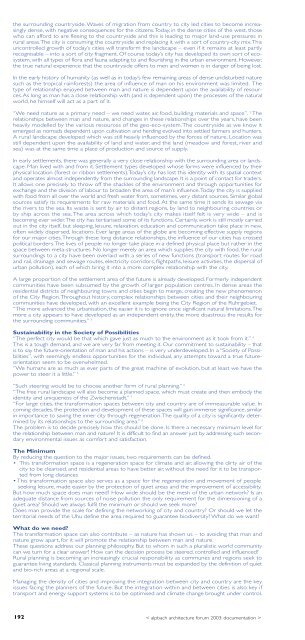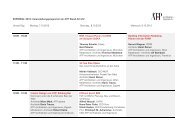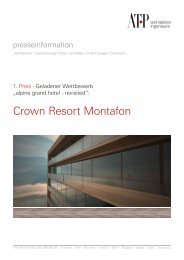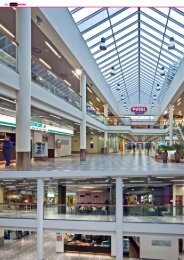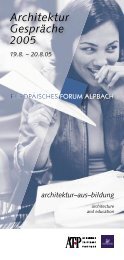alpbacher architekturgespräche 2003 - ATP
alpbacher architekturgespräche 2003 - ATP
alpbacher architekturgespräche 2003 - ATP
Sie wollen auch ein ePaper? Erhöhen Sie die Reichweite Ihrer Titel.
YUMPU macht aus Druck-PDFs automatisch weboptimierte ePaper, die Google liebt.
the surrounding countryside.Waves of migration from country to city led cities to become increasingly<br />
dense, with negative consequences for the citizens.Today, in the dense cities of the west, those<br />
who can afford to are fleeing to the countryside and this is leading to major land-use pressures in<br />
rural areas.The city is consuming the countryside and replacing it with a sort of country-city mix.This<br />
uncontrolled growth of today’s cities will transform the landscape – even if it remains at least partly<br />
recognisable – into a sort of city fragment. Of course today’s city has developed its own sort of ecosystem,<br />
with all types of flora and fauna adapting to and flourishing in the urban environment. However,<br />
the true natural experience that the countryside offers to men and women is in danger of being lost.<br />
In the early history of humanity (as well as in today’s few remaining areas of dense undisturbed nature<br />
such as the tropical rainforests) the area of influence of man on his environment was limited. The<br />
type of relationship enjoyed between man and nature is dependent upon the availability of resources.As<br />
long as man has a close relationship with (and is dependent upon) the processes of the natural<br />
world, he himself will act as a part of it.<br />
“We need nature as a primary need – we need water, air, food, building materials and space”. 2 The<br />
relationships between man and nature, and changes in these relationships over the years, have been<br />
heavily modelled by the various resources of the geo-eco-system.The countryside as we know it<br />
emerged as nomads dependent upon cultivation and herding evolved into settled farmers and hunters.<br />
A rural landscape developed which was still heavily influenced by the forces of nature. Location was<br />
still dependent upon the availability of land and water, and the land (meadow and forest, river and<br />
sea) was at the same time a place of production and source of supply.<br />
In early settlements, there was generally a very close relationship with the surrounding area or landscape.<br />
Man lived with and from it. Settlement types developed whose forms were influenced by their<br />
physical location (forest or ribbon settlements).Today’s city has lost this identity with its spatial context<br />
and operates almost independently from the surrounding landscape. It is a point of contact for traders.<br />
It allows one precisely to throw off the shackles of the environment and through opportunities for<br />
exchange and the division of labour to broaden the area of man’s influence.Today the city is supplied<br />
with food from all over the world and fresh water from, sometimes, very distant sources. Similar global<br />
sources satisfy its requirements for raw materials and food. At the same time it sends its sewage via<br />
the rivers to the sea. Its waste is sent by air to distant regions, by land to neighbouring countries or<br />
by ship across the sea.The area across which today’s city makes itself felt is very wide – and is<br />
becoming ever wider.The city has tertiarised some of its functions. Certainly, work is still mostly carried<br />
out in the city itself, but sleeping, leisure, relaxation, education and communication take place in new,<br />
often widely dispersed, locations. Ever large areas of the globe are becoming effective supply regions<br />
for our major cities.Through these long distance relationships, the influence of our cities has crossed<br />
political borders.The lives of people no longer take place in a defined physical place but rather in the<br />
space between meta-structures. No longer merely an area which supplies the city with food, the rural<br />
surroundings to a city have been overlaid with a series of new functions (transport routes for road<br />
and rail, drainage and sewage routes, electricity corridors, flightpaths, leisure activities, the dispersal of<br />
urban pollution), each of which bring it into a more complex relationship with the city.<br />
A large proportion of the settlement area of the future is already developed. Formerly independent<br />
communities have been subsumed by the growth of larger population centres. In dense areas the<br />
residential districts of neighbouring towns and cities begin to merge, creating the new phenomenon<br />
of the City Region.Throughout history, complex relationships between cities and their neighbouring<br />
communities have developed, with an excellent example being the City Region of the Ruhrgebiet.<br />
“The more advanced the urbanisation, the easier it is to ignore once significant natural limitations.The<br />
more a city appears to have developed as an independent entity, the more disastrous the results for<br />
the surrounding communities.” 3<br />
Sustainability in the Society of Possibilities<br />
“The perfect city would be that which gave just as much to the environment as it took from it.” 4<br />
This is a tough demand, and we are very far from meeting it. Our commitment to sustainability – that<br />
is to say the future-orientation of man and his actions – is very underdeveloped. In a “Society of Possibilities”,<br />
with seemingly endless opportunities for the individual, any attempts toward a true futureorientation<br />
seem to be overwhelmed.<br />
“We humans are as much as ever parts of the great machine of evolution, but at least we have the<br />
power to steer it a little.” 5<br />
“Such steering would be to choose another form of rural planning.” 6<br />
“The free rural landscape will also become a planned space, which must create and then embody the<br />
identity and uniqueness of the Zwischenstadt.” 7<br />
“For large cities, the transformation spaces between city and country are of immeasurable value. In<br />
coming decades, the protection and development of these spaces will gain immense significance, similar<br />
in importance to saving the inner city through regeneration.The quality of a city is significantly determined<br />
by its relationships to the surrounding area.” 8<br />
The problem is to decide precisely how this should be done. Is there a necessary minimum level for<br />
the relationship between man and nature? It is difficult to find an answer just by addressing such secondary<br />
environmental issues as comfort and satisfaction.<br />
The Minimum<br />
By reducing the question to the major issues, two requirements can be defined.<br />
• This transformation space is a regeneration space for climate and air, allowing the dirty air of the<br />
city to be cleansed, and residential areas to have better air, without the need for it to be transported<br />
from long distances<br />
• This transformation space also serves as a space for the regeneration and movement of people<br />
seeking leisure, made easier by the protection of quiet areas and the improvement of accessibility.<br />
But how much space does man need? How wide should be the mesh of the urban network? Is an<br />
adequate distance from sources of noise pollution the only requirement for the dimensioning of a<br />
quiet area? Should we always fulfil the minimum or should we seek more?<br />
Does man provide the scale for defining the networking of city and country? Or should we let the<br />
territorial needs of the Uhu define the area required to guarantee biodiversity? What do we want?<br />
What do we need?<br />
This transformation space can also contribute – as nature has shown us – to avoiding that man and<br />
nature grow apart, for it will promote the relationship between man and nature.<br />
These questions address our planning philosophy. But to whom in such a pluralistic world community<br />
can we turn for a clear answer? How can the decision process be steered, controlled and influenced?<br />
Rural planning is becoming an increasingly crucial responsibility as communes and regions seek to<br />
guarantee living standards. Classical planning instruments must be expanded by the definition of quiet<br />
and bio-rich areas at a regional scale.<br />
Managing the density of cities and improving the integration between city and country are the key<br />
issues facing the planners of the future. But the integration within and between cities is also key if<br />
transport and energy support systems is to be optimised and climate change brought under control.<br />
192<br />
< alpbach architecture forum <strong>2003</strong>: documentation >


